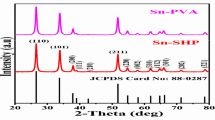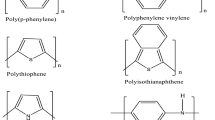Abstract
Firstly, poly[4-(4-vinylbenzyl)oxy)phthalonitrile]-co-styrene, [poly(VBOP-co-St], which is used as a linear copolymer precursor containing phthalonitrile pendant group was prepared from copolymerization of VBOP and St by atom transfer radical polymerization method at 110 °C. Then, complex synthesis of cobalt phthalocyanine in the single-chain polymer (SCP-CoPc complex) via the intramolecular macrocyclization reaction of cobalt and phthalonitrile group in poly(VBOP-co-St) was carried out at 150 °C in the presence of excess cyclohexanol. Both linear copolymer precursor and formation of cobalt phthalocyanine within a single-chain polymer were confirmed by FT-IR, 1H-NMR, 13C-NMR and UV/Vis spectroscopy techniques. Particularly, the formation of SCP-CoPc complex was characterized by almost disappearance of –C≡N band at 2230 cm−1 of the FT-IR and appearance of Q band around 672 nm and the B band in the near UV region at 350 nm of UV/Vis spectroscopy. The pure poly(VBOP-co-St), SCP-CoPc complex and the residue SCP-CoPc complex heated to 500 °C were characterized by SEM images, and the element analyses were estimated from X-ray energy dispersive spectroscopy (X-ray EDS). The EDS elemental analysis results of the residual of SCP-CoPc complex degraded to 500 °C showed that CoO [cobalt(II)oxide] compound occurred. The thermal properties of poly(VBOP-co-St) and SCP-CoPc complex were investigated through thermogravimetric analysis and differential scanning calorimeter. The conducting nanographene-based SCP-CoPc composites were prepared. DC and AC electrical conductivity and dielectric properties were investigated. The ac dielectric measurements of poly(VBOP-co-St), SCP-CoPc complex and composites were investigated at room temperature between 100 and 20 kHz depending on the alternating current conductivities. Also, the activation energy profile of SCP-CoPc/4% (by wt) nanographene composite was revealed by measuring the DC conductivity of individual composite material.















Similar content being viewed by others
References
Lyon CK, Prasher A, Hanlon AM, Tuten BT, Tooley CA, Frank PG, Berda EB (2014) A brief user’s guide to single-chain nanoparticles. Polym Chem 6:181–197
Landfester K, Bechthold N, Förster S, Antonietti M (1999) Evidence for the preservation of the particle identity in miniemulsion polymerization. Macromol Rapid Commun 20:81–84
Gillissen MAJ, Voets IK, Meijer EW, Palmans ARA (2012) Single chain polymeric nanoparticles as compartmentalised sensors for metal ions. Polym Chem 3:3166–3174
Terashima T, Mes T, De Greef TFA, Gillissen MAJ, Besenius P, Palmans ARA, Meijer EW (2011) Single-chain folding of polymers for catalytic systems in water. J Am Chem Soc 133:4742–4745
Perez-Baena I, Barroso-Bujans F, Gasser U, Arbe A, Moreno AJ, Colmenero J, Pomposo JA (2013) Endowing single-chain polymer nanoparticles with enzyme-mimetic activity. ACS Macro Lett 2:775–779
Huerta E, Stals PJM, Meijer EW, Palmans ARA (2012) Consequences of folding a water-soluble polymer around an organocatalyst. Angew Chem Int Ed 52:2906–29110
Davis KA, Matyjaszewski K (2002) Statistical, gradient, block, and graft copolymers by controlled/living radical polymerizations. Adv Polym Sci 159:2–13
Altintas O, Barner-Kowollik C (2016) Single-chain folding of synthetic polymers: a critical update. Macro Rapid Commun 37:29–46
Beers KL, Gaynor SG, Matyjaszewski K (1998) The synthesis of densely grafted copolymers by atom transfer radical polymerization. Macromol 31:9413–9415
Li L, Tang Q, Li H, Hu W, Yang X, Shuai Z, Liu Y, Zhu D (2008) Organic thin-film transistors of phthalocyanines. Pure Appl Chem 80:2231–2240
Loi MA, Denk P, Hoppe H, Neugebauer H, Winder C, Meissner D, Brabec C, Serdar NS, Gouloumis A, Vazquez P, Torres T (2003) Long-lived photoinduced charge separation for solar cell applications in phthalocyanine–fulleropyrrolidine dyad thin films. J Mater Chem 13:700–704
Blochwitz J, Pfeiffer M, Fritz T, Leo K (1998) Low voltage organic light emitting diodes featuring doped phthalocyanine as hole transport material. Appl Phys Lett 73:729–731
Peyman SHA, Gabriel C (2007) Dielectric properties of tissues at microwave frequencies. Phys Med Biol 52:2229–2245
Jonghwa J, Yun-Jung L, Bohyun K, Byoungjae K, Ki-Suck J, Hyun-jong P (2015) Colored single-chain nanoparticle via intramolecular copper phthalocyanines formation. Polym Chem 6:3392–3397
Manley-King CI, Bergh JJ, Petzer JP (2012) Monoamine oxidase inhibition by C4-substituted phthalontriles. Bioorg Chem 40:114–124
Surya PS, Saim E, Alexandre L (2010) Synthesis of highly soluble phthalocyanine from a new phthalonitrile under mild conditions. Adv Mater Lett 1(2):148–150
Özge G, Tugba S, Metin A, Kasım MŞ (2017) Efficient synthesis of EDOT modified ABBB-type unsymmetrical zinc phthalocyanine: optoelectrocromic and glucose sensing properties of its copolymerization film. New J Chem 41:14080–14087
Jiang Z, Ou Z, Chen N, Wang J, Huang J, Shao J, Kadish KM (2005) Synthesis, spectral and electrochemical characterization of non-aggregating α-substituted vanadium(IV)-oxo phthalocyanines. J Porphyr Phthalocyanines 9:352–360
Chrissafis K (2009) Kinetics of thermal degradation of polymers complementary use of isoconversional and model-fitting methods. J Therm Anal Calorim 95:273–283
Kissinger HE (1957) Reaction kinetics in differential thermal analysis. Anal Chem 29:1702–1706
Ozawa T (1965) A new method of analyzing thermogravimetric data. Bull Chem Soc Jpn 38:1881–1886
Flynn JH, Wall LA (1966) General treatment of the thermogravimetry of polymers. J Res Natl Bur Stand 70A(6):487–523
Vyazovkin S (1996) A unified approach to kinetic processing of nonisothermal data. Int J Chem Kinet 28:95–101
Broido A (1969) A simple, sensitive graphical method of treating thermogravimetric analysis data. J Polym Sci A 2 Polym Phys 1773:1761–1773
Coats W, Redfern JP (1964) Kinetic parameters from thermogravimetric data. Nature 201:68–69
Mehdihasan IS, Kaushal PP, Rajnikant MP (2018) Electrospun ZnO nanoparticles doped core-sheath nanofibers: characterization and antimicrobial properties. J Polym Environ 26:4376–4387
Mehdihasan IS, Dijit MP, Nirmal NP, Umesh SP, Kaushal PP, Rajnikant MP (2018) Methacrylate copolymers and their composites with nano-CdS: synthesis, characterization, thermal behavior, and antimicrobial properties. Int J Ind Chem 9:153–166
Açikses A, Çömez N, Biryan F (2019) Metal complexes of a homopolymer system containing diethanolamine side group: synthesis and dielectrical behaviors. J Macromol Sci Part A Pure Appl Chem 56:253–266
Saad ALG, Hassan AM, Youssif MA, Ahmed MGM (1997) Studies of electrical properties of some fire-retarding poly(vinyl chloride) compositions. J Appl Polym Sci 65:27–35
Biryan F, Demirelli K, Torğut G, Pıhtılı G (2017) Synthesis, thermal degradation and dielectric properties of poly[2-hydroxy,3-(1-naphthyloxy)propyl methacrylate]. Polym Bull 74(2):583–602
Hema M, Selvasekerpandian S, Sakunthala A, Arunkumar D, Nithya H (2008) Structural, vibrational and electrical characterization of PVA–NH4Br polymer electrolyte system. Phys B 403:2740–2747
Mondal SP, Aluguri R, Ray SK (2009) Dielectric and transport properties of carbon nanotube-CdS nanostructures embedded in polyvinyl alcohol matrix. J Appl Phys 105:114317–114323
Deshmukh K, Ahamed B, Sadasivuni KK, Ponnamma D, AlMaadeed MA, Pasha SKK, Chidambaram PK (2017) Graphene oxide reinforced poly (4-styrenesulfonic acid)/polyvinyl alcohol blend composites with enhanced dielectric properties for portable and flexible electronics. Mater Chem Phys 186:188–201
Yang W, Lingjie Z, Jun Z, Beibei J, Yingye J, Junkai W, Menglan W, Yonghong C, Kai W (2019) Dielectric properties and thermal conductivity of epoxy resin composite modified by Zn/ZnO/Al2O3 core–shell particles. Polym Bull 76:3957–3970
Rajesh C, Manoj KC, Unnikrishnan G, Purushothaman E (2013) Dielectric properties of short nylon-6 fiber-reinforced NBR composites. Adv Polym Technol 32:90–102
Jawad SA, Al-Jundi J, El-Ghanem HM (2003) DC electrical properties of graphitized carbon-black filled rubbers. Int J Polym Mater 52(9):809–820
Biryan F, Demirelli K (2017) Copolymerization of benzyl methacrylate and a methacrylate bearing benzophenoxy and hydroxyl side groups: monomer reactivity ratios, thermal studies and dielectric measurements. Fibers Polym 18(9):1629–1637
Drobny JG (2012) Polymeric materials, 1st edn. Wiley, Hoboken
Shubha A, Manohara SR, Gerward L (2017) Influence of polyvinylpyrrolidone on optical, electrical, and dielectric properties of poly(2-ethyl-2-oxazoline)-polyvinylpyrrolidone blends. J Mol Liq 247:328–336
Chetia JR, Maullick M, Dutta A, Dass NN (2004) Role of poly(2-dimethylaminoethylmethacerylate) salt as solid state ionics. Mater Sci Eng B 107:134–138
Author information
Authors and Affiliations
Corresponding author
Additional information
Publisher's Note
Springer Nature remains neutral with regard to jurisdictional claims in published maps and institutional affiliations.
Rights and permissions
About this article
Cite this article
Biryan, F., Tuncer, H. & Demirelli, K. Electrical, thermal behaviors and synthesis of intramolecular cobalt phthalocyanine with single-chain polymer structure. Polym. Bull. 77, 2461–2484 (2020). https://doi.org/10.1007/s00289-019-02871-3
Received:
Revised:
Accepted:
Published:
Issue Date:
DOI: https://doi.org/10.1007/s00289-019-02871-3




